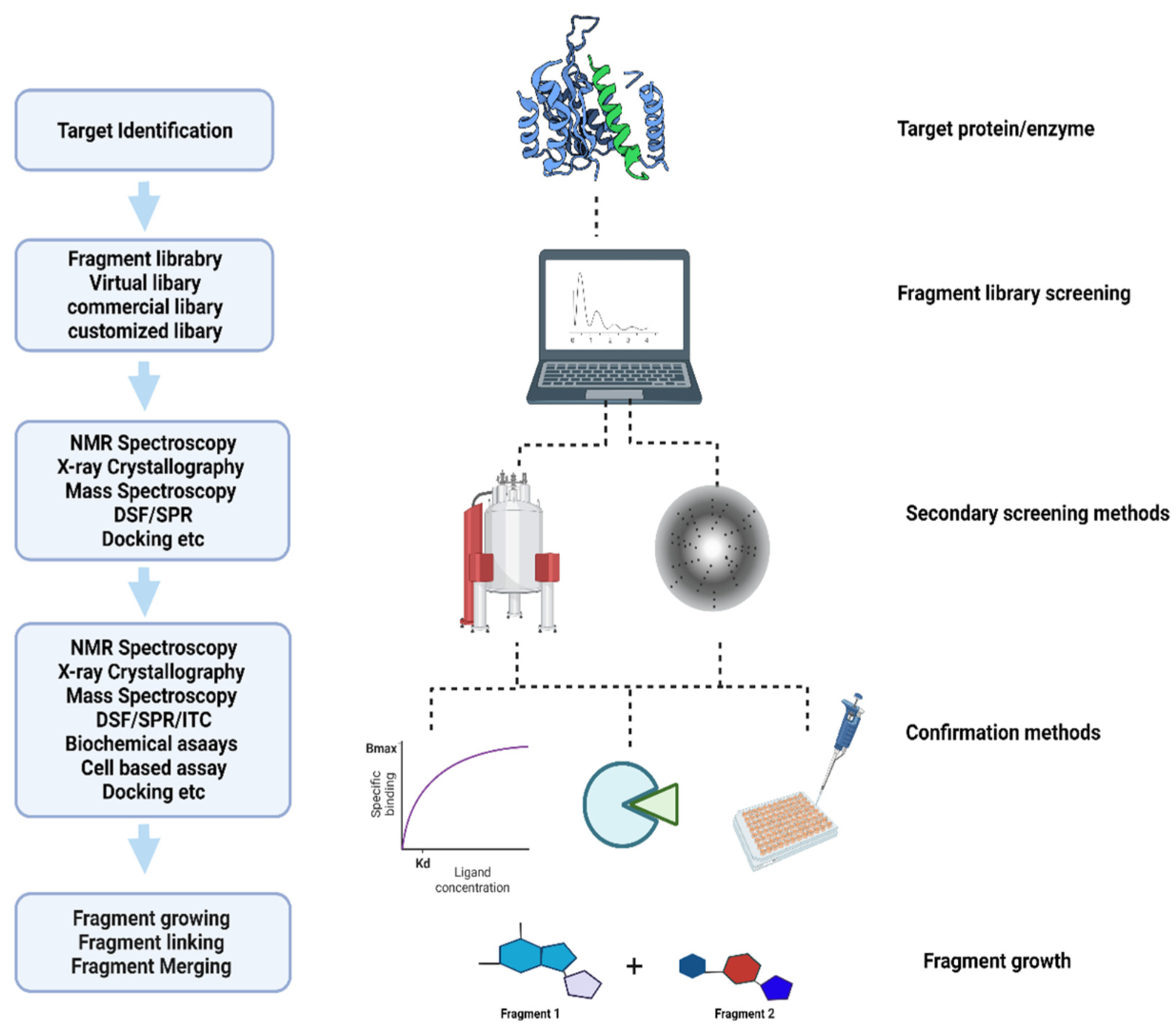Fragment Based Drug Discovery Service
Fragment-based drug discovery (FBDD) is a powerful approach that begins with the identification of low-molecular-weight chemical fragments capable of binding to a biological target of interest. These fragments serve as efficient starting points of drug discovery due to their small size, high ligand efficiency, and structural simplicity. Once suitable fragment hits are identified, they can be systematically optimized through expansion, growth, merging, or linking strategies to develop more complex and high-affinity compounds.

Figure 1. An Overview of Fragment-Based Drug Discovery (FBDD)
Compared to high-throughput screening (HTS), which often relies on testing large libraries of complex molecules, fragment-based drug discovery (FBDD) starts with smaller, simpler compounds that offer higher ligand efficiency. While HTS hits may require extensive structural modification to improve their binding, fragments identified through FBDD can be more readily optimized into potent leads, reducing the need for large-scale redesign and saving both time and resources.
Service at MtoZ Biolabs
MtoZ Biolabs delivers a comprehensive Fragment Based Drug Discovery Service that integrates state-of-the-art technologies with deep expertise in medicinal chemistry, structural biology, and computational modeling.
We employ diverse methods to characterize fragment-target interactions, including:
💠Nuclear Magnetic Resonance (NMR) Spectroscopy for detecting weak binding events and mapping interaction sites;
💠X-ray Crystallography and Cryo-Electron Microscopy (Cryo-EM) for high-resolution structural elucidation of fragment-bound complexes;
💠Surface Plasmon Resonance (SPR) for real-time kinetic analysis of fragment binding affinities;
💠Differential Scanning Fluorimetry (DSF) for assessing thermal stability shifts upon fragment binding;
💠Isothermal Titration Calorimetry (ITC) for label-free quantification of binding thermodynamics;
💠Mass Spectrometry to support fragment screening via covalent labeling, native MS, or HDX workflows.
In parallel, we utilize molecular docking and structure-based design to prioritize and refine fragment candidates, especially for challenging targets with limited structural information. This hybrid strategy ensures that each selected fragment has both validated binding and structural tractability, forming a solid foundation for downstream lead development.
Analysis Workflow
1. Target Preparation
Recombinant expression and purification of the target protein under buffer conditions suitable for biophysical assays and structural analysis.
2. Fragment Library Screening
We utilize high-quality, diverse fragment libraries to identify initial binders. Primary screening is conducted using NMR, SPR, or DSF depending on the target class.
3. Hit Validation and Characterization
Positive hits from primary screens are subjected to secondary validation using orthogonal techniques such as ITC or crystallography. Binding kinetics, thermodynamics, and specificity are evaluated.
4. Structural Elucidation
High-resolution structures of fragment-target complexes are obtained via X-ray crystallography or Cryo-EM to guide subsequent optimization steps.
5. Fragment Evolution and Optimization
Medicinal chemistry teams employ strategies such as fragment growing, linking, or merging to improve potency, selectivity, and pharmacokinetics.
6. In Vitro Biological Assays
Optimized compounds are tested in biochemical and cell-based assays to assess activity, cytotoxicity, and preliminary ADME profiles.
7. Lead Nomination
Final leads are selected based on a balanced profile of potency, selectivity, developability, and safety.

Figure 2. Flow Chart of Fragment-Based Drug Discovery
Service Advantages
✔️Customizable Workflow: Tailored design, screening, and optimization strategies based on target characteristics and project goals.
✔️Robust Platform: Integrates SPR, NMR, DSF, ITC, X-ray, Cryo-EM, and MS for sensitive and accurate fragment validation.
✔️Cost-Effective Early Discovery: Fragment-based approaches reduce compound complexity and screening costs while maintaining high-quality lead potential.
✔️Experienced Scientific Team: Our team brings extensive expertise in fragment screening, structural biology, and medicinal chemistry, ensuring informed decision-making and streamlined project execution at every stage.
What Could be Included in the Report?
1. Comprehensive experimental details
2. Fragment screening report (Screening methodology and experimental conditions)
3. Biophysical screening data (e.g., SPR, ITC, DSF)
4. High-resolution structure files of fragment-target complexes
5. Fragment growth, linking, or merging strategies
6. Other detailed information of fragment-based drug discovery
If you are interested in our Fragment Based Drug Discovery Service, please feel free to contact us!
Related Services
Structure-Based Drug Discovery Service
High Throughput Drug Discovery Service
Hit Identification Service | Drug Discovery
How to order?







